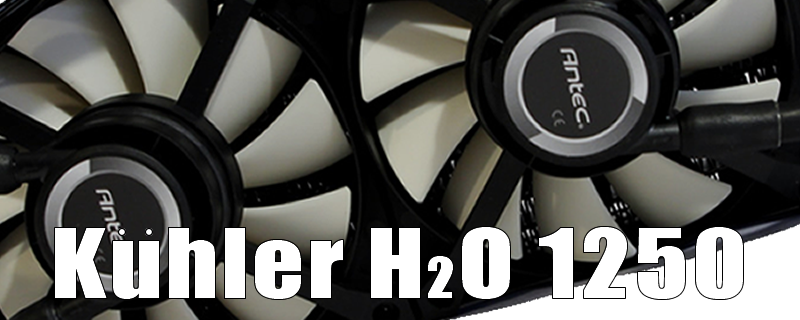Antec Kuhler H2O 1250 Review
Conclusion
In producing the Kuhler H2O 1250, with its combined fan and pump motors, Antec have certainly separated themselves from the rest of the pack. The question though is whether this is engineering for engineering’s sake or whether there are real benefits to be had from this alternate approach to the AIO. Before we pass judgement let’s take the time to give it a thorough going over in its own right.
Antec may not be the first name you think of when recalling a list of top tier manufacturers, particularly when it comes to build quality and finish. That said we could find nothing at all wrong with the Kuhler. It came well packed in identical egg box packaging to the likes of Corsair and Cooler Master units. The contents were protected in polythene bags, the instructions were clear and there were plentiful fittings and screws for every CPU socket made since Adam was a lad. The Radiator has been well put together with no evidence of bent fins, the finish was glossy and evenly applied. All tubing curves were of a constant radius with no hint of kinking, with the junctions between barbs and tubing appearing strong. Just a shame that Antec don’t seem to mind as much as we do whether their logo appears on the wonk once the cold plate is fitted.
If you’re the sort that uses instructions you’ll find them informative and helpful. The fitting process is a simple one utilising a single locating ring and back plate for both Intel and AMD. We were a bit worried about the locating ring staying in place when we were lining things up as it doesn’t lock to the cold plate very securely however in practice things went swimmingly. The 300mm of tubing in the system is about standard and should be plenty for most cases, with the tubing being very pliant without hinting a kinking.
The Kuhler 1250 is best used with the bundled “Grid” software as this allows pre-defined profiles and custom speeds to be set. It also enables the colour of the RGB LED array in the centre of the cold plate to be altered to pretty much anything you can think of and a few in between, remembering of course that us blokes only actually recognise 7 colours. Peach is not a colour it’s a fruit, and we have no idea what Cyan and magenta are. One issue we did encounter that has perturbed us slightly is that whether you select a silent profile or specify the exact speed you want your fans to spin at using the “Custom” function, the software always seems to increase the speed a few hundred RPM when the system is under load. In other words, if you select 1500rpm, when you start gaming or undertake other tasks that will push heat into the system, the fan speed will rise up to about 1700rpm. In some ways this is good, and we can kind of appreciate it if you’ve selected “Silent” but we do think that in Custom mode at least whatever number you dial up should be the number it stays at.
In use the cooler is extremely quiet when in Silent mode and provided you don’t load it too much it will stay this way. With a mild overclock, adding basic activity and therefore some heat increases the fan speed from 600rpm to just under 800rpm. It’s still pretty quiet to be honest but just about audible. If you go gaming the software will ramp things up to around 1400RPM. In balanced mode we dialled in 1700rpm with the dashboard display telling us they were actually running at about 1650rpm. At this speed the fans are audible but not intrusive and again will up their speed to account for additional load. With everything cranked all the way up the fans are decidedly on the loud side, as you might expect for something turning at 2100rpm. The cooling on offer up here is reasonable but the noise would only be liveable with if you were gaming with a headset or loud speakers.
The performance of the Kuhler isn’t as good as we were expecting, especially at the high end. With its fans spinning at an ear splitting 2100RPM the Kuhler 1250 is very loud indeed yet fails to match the performance of a great many other 240mm based AIOs. We’re not sure whether the issue is the rad or the fans, and being as the fans are not interchangeable there’s no way of swapping them out for potentially better and quieter units. At lower and balanced fan speeds the Kuhler falls into the middle of the pack, in some cases behind smaller and cheaper 120mm based units.
At the beginning of this conclusion we asked whether we thought the design of the Kuhler 1250 was engineering for engineering’s sake. We have to say that although we like the design, and certainly the altered aesthetic that comes with having tubing moving to and from the rads to the pump/fan hubs, the design does bring with it certain limitations. Although we appreciate that there are those out there who will buy an AIO and just stick it in, there are others, like us, for whom it is a cardinal sin not to have all their case fans matching. Add in the point that the performance metrics of the cooler would also indicate that the fans are letting it down and we think not being able to change them out is a severe limitation. The second issue we have is that by combining the pump and fan motors Antec have, by necessity, had to make the hubs quite tall. This in turn has raised the profile of the whole assembly up to 75mm, which we think will cause interference issues if smaller Mid Tower cases are combined with motherboards with large heat sinks or tall RAM heat sinks. On the plus side you are left with a very low profile cold plate, but being as having a slightly taller cold plate doesn’t really cause that many, if any problems we’re no entirely sure what the upside of this trade-off is.
We were hoping that this new design from Antec would bring us something different and it has. Unfortunately that difference is not a positive one. For the same money you can pick up a quieter and better performing H105 or H100i. Even some twin fan 120mm based units such as the H80i and X60 come close to offering the same performance while taking up less room, at lower cost and with less noise. Kuhler by name but unfortunately not Kuhl by nature.Â
We’re giving it a Bronze because although it doesn’t perform as well as some of the others, provided you don’t push it too hard it is capable and very quiet at low speeds and low loadings. We’re also bestowing the innovation award as although Antec might no have got things 100% right, they are at least trying to break the mould.Â
Thanks to Antec for sending in the 1250, you can discuss your thoughts in the OC3D Forums.
New Page





